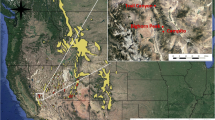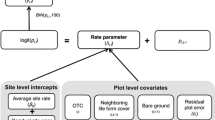Abstract
The annual grasses red brome (Bromus rubens L.) and cheatgrass (Bromus tectorum L.) are associated with increased frequency and size of wildfires in the Great Basin and Mojave deserts of North America. Invasion success of these exotic grasses is driven in part by germination responses to climate fluctuations. Understanding how climate influences germination characteristics of invasive grasses is critical to predicting desert wildfire. While the germination characteristics of cheatgrass have been reported, the germination requirements for red brome, the exotic grass associated with fire in the Mojave Desert, have not. Herein we characterize germination response of red brome through hydrothermal-time modeling. The hydrothermal-time requirements were matched with historic climate data to estimate optimal germination periods for red brome and its potential association with wildfire. The optimal temperature for germination in a population of red brome seeds was 19.3 °C with a hydrothermal-time constant of 38.9 MPa °C days and a mean base water potential of −1.35 MPa. Based on the hydrothermal model, high red brome germination rates are most likely to occur in wet Octobers when optimal fall temperatures overlap with adequate moisture. Abnormally high precipitation totals in the fall of 2004 created ideal conditions for red brome germination that likely contributed to the large-scale Mojave Desert fires of 2005. Predicted intensification of fall and winter precipitation events in response to climate change will likely drive further increases in red brome abundance and subsequently more widespread fire in regions of the Mojave Desert.




Similar content being viewed by others
References
Abella SR, Embrey TM, Schmid SM, Prengaman KA (2012) Biophysical correlates with the distribution of the invasive annual red brome (Bromus rubens) on a Mojave Desert landscape. Invasive Plant Sci Manag 5:47–56
Agnew ADQ (1997) Switches, pulses and grazing in arid vegetation. J Arid Environ 37:609–617
Allen PS, Meyer SE, Beckstead J (1995) Patterns of seed after-ripening in Bromus tectorum L. J Exp Bot 46:1737–1744
Allen PS, Meyer SE, Khan MA (2000) Hydrothermal time as a tool in comparative germination studies. Seed biology: advances and applications. CABI Publishing, Wallingford, pp 401–410
Alvarado V, Bradford KJ (2002) A hydrothermal time model explains the cardinal temperatures for seed germination. Plant Cell Environ 25:1061–1069
Angert AL, Huxman TE, Barron-Gafford GA et al (2007) Linking growth strategies to long-term population dynamics in a guild of desert annuals. J Ecol 95:321–331
Bair NB, Meyer SE, Allen PS (2006) A hydrothermal after-ripening time model for seed dormancy loss in Bromus tectorum L. Seed Sci Res 16:17–28
Bauer MC, Meyer SE, Allen PS (1998) A simulation model to predict seed dormancy loss in the field for Bromus tectorum L. J Exp Bot 49:1235–1244
Beatley JC (1966) Ecological status of introduced brome grasses (Bromus Spp.) in desert vegetation of southern Nevada. Ecology 47:548–554
Beatley JC (1976) Rainfall and fluctuating plant populations in relation to distributions and numbers of desert rodents in southern Nevada. Oecologia 24:21–42
Beckstead J, Meyer SE, Allen PS (1996) Bromus tectorum seed germination: between-population and between-year variation. Can J Bot 74:875–882
Beckstead J, Meyer SE, Molder CJ, Smith C (2007) A race for survival: can Bromus tectorum seeds escape Pyrenophora semeniperda-caused mortality by germinating quickly? Ann Bot 99:907–914
Bradford KJ (1995) Water relations in seed germination. In: Kigel J, Galili G (eds) Seed development and germination. CRC Press, Boca Raton, pp 351–396
Bradford KJ (2002) Applications of hydrothermal time to quantifying and modeling seed germination and dormancy. Weed Sci 50:248–260
Brooks ML (1999) Alien annual grasses and fire in the Mojave Desert. Madrono 46:13–19
Brooks ML (2012) Effects of high fire frequency in creosote bush scrub vegetation of the Mojave Desert. Int J Wildland Fire 21:61–68
Brooks ML, Chambers JC (2011) Resistance to invasion and resilience to fire in desert shrublands of North America. Rangel Ecol Manag 64:431–438
Brooks ML, Matchett JR (2006) Spatial and temporal patterns of wildfires in the Mojave Desert, 1980–2004. J Arid Environ 67:148–164
Brooks ML, D’Antonio CM, Richardson DM et al (2004) Effects of invasive alien plants on fire regimes. Bioscience 54:677
Callison J, Brotherson JD, Bowns JE (1985) The effects of fire on the blackbrush [Coleogyne ramosissima] Community of Southwestern Utah. J Range Manag 38:535–538
Chambers JC, Roundy BA, Blank RR et al (2007) What makes Great Basin sagebrush ecosystems invasible by Bromus tectorum? Ecol Monogr 77:117–145
Chapin FS III, Zavaleta ES, Eviner VT et al (2000) Consequences of changing biodiversity. Nature 405:234–242
Christensen M, Meyer SE, Allen PS (1996) A hydrothermal time model of seed after-ripening in Bromus Tectorum L. Seed Sci Res 6:155–164
Corbineau F, Belaid D, Come P (1992) Dormancy of Bromus rubens L. seeds in relation to temperature, light and oxygen effects. Weed Res 32:303–310
D’Antonio CM (2000) Fire, plant invasions, and global changes. In: Mooney HA, Hobbs RJ (eds) Invasive species in a changing world. Island Press, Covelo, pp 65–93
D’Antonio CM, Vitousek PM (1992) Biological invasions by exotic grasses, the grass/fire cycle, and global change. Annu Rev Ecol Syst 23:63–87
Eidenshink J, Schwind B, Brewer K et al (2007) A project for monitoring trends in burn severity. J Assoc Fire Ecol 3:3
Engel EC, Abella SR (2011) Vegetation recovery in a desert landscape after wildfires: influences of community type, time since fire and contingency effects. J Appl Ecol 48:1401–1410
Finch-Savage WE, Leubner-Metzger G (2006) Seed dormancy and the control of germination. New Phytol 171:501–523
Gummerson RJ (1986) The effect of constant temperatures and osmotic potentials on the germination of sugar beet. J Exp Bot 37:729–741
Hardegree SP, Emmerich WE (1990) Effect of polyethylene glycol exclusion on the water potential of solution-saturated filter paper. Plant Physiol 92:462–466
Hereford R, Webb RH, Longpré CI (2006) Precipitation history and ecosystem response to multidecadal precipitation variability in the Mojave Desert region, 1893–2001. J Arid Environ 67:13–34
Hunter R (1991) Bromus invasions on the Nevada Test Site: present status of B. rubens and B. tectorum with notes on their relationship to disturbance and altitude. West N Am Nat 51:176–182
Huxman TE, Snyder KA, Tissue D et al (2004) Precipitation pulses and carbon fluxes in semiarid and arid ecosystems. Oecologia 141:254–268
IPCC (2007) Climate Change 2007: The Physical Science Basis. Contribution of working group I to the fourth assessment report of the intergovernmental panel on climate change. Cambridge University Press, Cambridge, United Kingdom and New York, NY, USA
Jentsch A, Beierkuhnlein C (2008) Research frontiers in climate change: effects of extreme meteorological events on ecosystems. Comptes Rend Geosci 340:621–628
Jurand BS, Abella SR, Suazo AA (2013) Soil seed bank longevity of the exotic annual grass Bromus rubens in the Mojave Desert, USA. J Arid Environ 94:68–75
Loik ME, Breshears DD, Lauenroth WK, Belnap J (2004) A multi-scale perspective of water pulses in dryland ecosystems: climatology and ecohydrology of the western USA. Oecologia 141:269–281
Merrill KR, Meyer SE, Coleman CE (2012) Population genetic analysis of Bromus tectorum (Poaceae) indicates recent range expansion may be facilitated by specialist genotypes. Am J Bot 99:529–537
MesoWest MesoWest Station Interface. http://mesowest.utah.edu/. Accessed 1 Aug 2011
Meyer SE, Allen PS (2009) Predicting seed dormancy loss and germination timing for Bromus tectorum in a semi-arid environment using hydrothermal time models. Seed Sci Res 19:225–239
Meyer SE, Stewart TE, Clement S (2010) The quick and the deadly: growth versus virulence in a seed bank pathogen. New Phytol 187:209–216
Michel BE (1983) Evaluation of the water potentials of solutions of polyethylene glycol 8000 both in the absence and presence of other solutes. Plant Physiol 72:66–70
Potts DL, Huxman TE, Cable JM et al (2006) Antecedent moisture and seasonal precipitation influence the response of canopy-scale carbon and water exchange to rainfall pulses in a semi-arid grassland. New Phytol 170:849–860
Reid CR, Goodrich S, Bowns JE (2008) Cheatgrass and red brome; the history and biology of two invaders. In: Proceedings—Shrublands under fire: disturbance and recovery in a changing world. U.S. Department of Agriculture, Forest Service, Rocky Mountain Research Station, pp 27–32
Reynolds MBJ, DeFalco LA, Esque TC (2012) Short seed longevity, variable germination conditions, and infrequent establishment events provide a narrow window for Yucca brevifolia (Agavaceae) recruitment. Am J Bot 99:1647–1654
Roundy BA, Hardegree SP, Chambers JC, Whittaker A (2007) Prediction of cheatgrass field germination potential using wet thermal accumulation. Rangel Ecol Manag 60:613–623
Rowse H, Finch-Savage W (2003) Hydrothermal threshold models can describe the germination response of carrot (Daucus carota) and onion (Allium cepa) seed populations across both sub- and supra-optimal temperatures. New Phytol 158:101–108
Salo LF (2004) Population dynamics of red brome (Bromus madritensis subsp. rubens): times for concern, opportunities for management. J Arid Environ 57:291–296
Salo LF (2005) Red brome (Bromus rubens subsp. madritensis) in North America: possible modes for early introductions, subsequent spread. Biol Invasions 7:165–180
Scott J, Meyer S, Merrill K, Anderson V (2010) Local population differentiation in Bromus tectorum L. in relation to habitat-specific selection regimes. Evol Ecol 24:1061–1080
Snyder KA, Tartowski SL (2006) Multi-scale temporal variation in water availability: implications for vegetation dynamics in arid and semi-arid ecosystems. J Arid Environ 65:219–234
Vamstad MS, Rotenberry JT (2010) Effects of fire on vegetation and small mammal communities in a Mojave Desert Joshua tree woodland. J Arid Environ 74:1309–1318
Wallace A (1972) Radioecology and ecophysiology of desert plants at the Nevada Test Site. U.S. Atomic Energy Commission, Office of Information Services; available from the National Technical Information Service, Springfield, Virginia
Westerling AL, Gershunov A, Brown TJ et al (2003) Climate and wildfire in the western United States. Bull Am Meteorol Soc 84:595–604
Wu KK, Jain SK (1979) Population regulation in Bromus rubens and B. mollis: life cycle components and competition. Oecologia 39:337–357
Zouhar K, Smith JK, Sutherland S, Brooks ML (2008) Wildland fire in ecosystems: fire and nonnative invasive plants. Department of Agriculture, Forest Service, Rocky Mountain Research Station, Ogden
Acknowledgments
We gratefully acknowledge the expert review of Dr. Phil Allen in the preparation of this manuscript and the technical assistance of Heather Finch-Boekweg in conducting the experiment. We express appreciation for the use of Brigham Young University’s Lytle Ranch Preserve, which provided accommodations while working at field sites. This research was funded by the Sant Educational Endowment for a Sustainable Environment, the Redd Center, the United States Department of Agriculture NIFA award number 2010-04092, and the United States Department of Interior BLM.
Author information
Authors and Affiliations
Corresponding author
Rights and permissions
About this article
Cite this article
Horn, K.J., Nettles, R. & Clair, S.B.S. Germination response to temperature and moisture to predict distributions of the invasive grass red brome and wildfire. Biol Invasions 17, 1849–1857 (2015). https://doi.org/10.1007/s10530-015-0841-3
Received:
Accepted:
Published:
Issue Date:
DOI: https://doi.org/10.1007/s10530-015-0841-3




